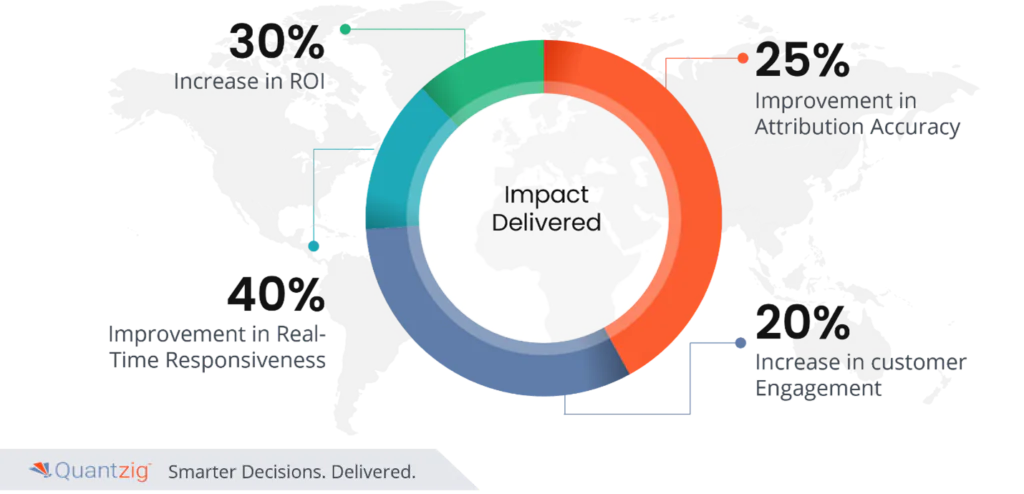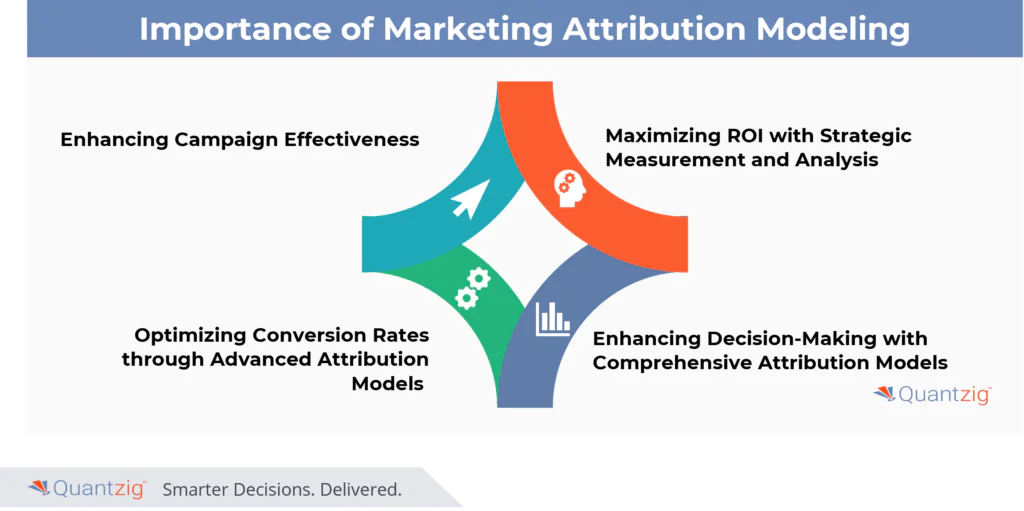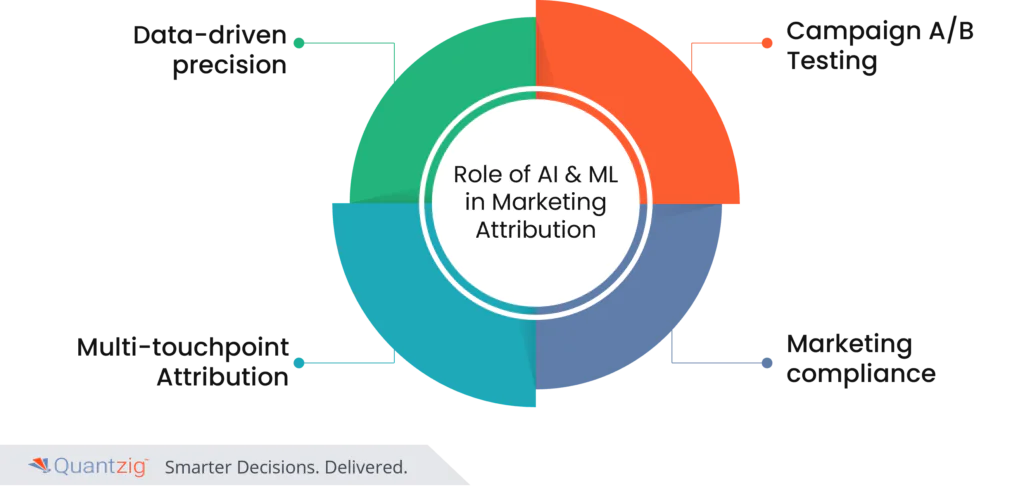Table of Contents
Introduction to Marketing Attribution in Ecommerce
In the fast-paced and ever-evolving landscape of modern marketing, the emergence of artificial intelligence (AI) has sparked a revolution that is reshaping the game entirely. The rise of tracking limitations and cookie restrictions has made rule-based traditional marketing methods difficult to implement. This is where AI and ML in marketing come in, as it offers an alternative way for eCommerce firms to attribute conversions to effective marketing channels. In this case study, we’ll shed light on how a leading e-commerce retailer with a global presence achieved a 25% improvement in Attribution Accuracy, 30% boost in ROI, 40% improvement in real-time Responsiveness, and 20% upsurge in customer engagement with Quantzig’s Marketing Analytics Solutions.
Book a demo to experience the meaningful insights we derive from data through our analytical tools and platform capabilities. Schedule a demo today!
Request a Free DemoQuantzig’s Success Story:
| Client Details | A leading e-commerce retailer based on UK renowned for its diverse range of products. |
| Challenges Faced by the Client | The client faced challenges in gaining a comprehensive understanding of customer interactions across channels, struggled with ineffective resource allocation due to inaccurate attribution, and lacked real-time optimization capabilities for adapting marketing strategies. |
| Solutions Offered by Quantzig | Quantzig revolutionized the client’s marketing attribution by implementing AI and ML-driven solutions, including multi-touchpoint analysis for accurate attribution, real-time insights for agile optimization, predictive analytics for proactive strategy adjustments, and personalized experiences to enhance customer engagement and loyalty. |
| Impact Delivered | Attribution Accuracy Improved by 25%, ROI boost of 30%, Real-time Responsiveness improved by 40%, and Customer Engagement Upsurge by 20% |
Our recent client, a leading e-commerce retailer with a global presence, faced a crucial challenge in their marketing efforts. Despite substantial investments in diverse marketing channels, they struggled to determine the most effective touchpoints in their customer journey. Lacking the ability to attribute conversions accurately, their marketing strategies lacked optimization, leading to suboptimal ROI and limited customer engagement. They sought a game-changing solution to unravel the complexities of their marketing attribution and drive data-driven success.
Challenges Faced by the Client:
- Limited Visibility: They lacked a comprehensive view of their customers’ interactions across channels, making it challenging to identify the most influential touchpoints.
- Inefficient Resource Allocation: Without accurate attribution, the company struggled to allocate resources effectively, leading to wasted budget and missed opportunities.
- Real-time Optimization: The client needed the ability to adapt marketing strategies in real-time to capitalize on emerging trends and customer behavior.
Solutions Offered by Quantzig:
Quantzig, renowned data analytics, and AI-driven solutions provider, stepped in to revolutionize the client’s marketing attribution with AI and ML.
- Multi-Touchpoint Analysis: Our team implemented advanced AI algorithms and automation to analyze vast datasets, attributing conversions accurately across multiple touchpoints.
- Real-Time Insights: With AI’s real-time capabilities, we empowered the client to access actionable insights, enabling agile campaign optimization.
- Predictive Analytics: Our ML-driven predictive analytics forecasted customer behavior, guiding them in proactive strategies for better ROI.
- Personalization at Scale: Leveraging automation, AL and ML in marketing, we delivered hyper-personalized experiences, enhancing customer engagement and loyalty.
Impact Delivered:

The implementation of marketing attribution modeling yielded significant improvements across key performance indicators for the client. With a 25% increase in attribution accuracy, the client gained a more precise understanding of the effectiveness of their marketing efforts, allowing for better-informed decision-making and resource allocation. This, coupled with a notable 30% boost in ROI, showcased the tangible returns on their investment in attribution modeling.
Real-time responsiveness saw a remarkable 40% improvement, enabling the client to adapt swiftly to emerging trends and capitalize on evolving customer behaviors, thus enhancing their agility in the marketplace. Furthermore, the substantial 20% upsurge in customer engagement underscored the success of personalized experiences facilitated by the adoption of automation, AI and ML technologies, leading to heightened loyalty and satisfaction among their customer bases. Overall, these impactful outcomes underscored the transformative potential of marketing attribution modeling in driving business growth and success.
Are you ready to revolutionize your marketing attribution and achieve extraordinary results like our client? Embrace the power of AI and ML-driven solutions with Quantzig and unlock the full potential of your marketing efforts.
Experience the advantages firsthand by testing a customized complimentary pilot designed to address your specific requirements. Pilot studies are non-committal in nature.
Request a Free PilotThe Importance of Marketing Attribution in Ecommerce

Marketing attribution modeling helps allocate marketing budgets by identifying which channels and campaigns generate the highest Return on investment (ROI). By understanding the customer journey better through attribution modeling, marketers can optimize their marketing strategies and tactics for improved results. It provides valuable insights by analyzing customer interactions, ads, and touchpoints. By assigning appropriate weight to each interaction, it offers a comprehensive view of campaign performance. This approach aids in informed decision-making, reporting, and Customer Lifetime Value, enabling businesses to optimize resource allocation and refine their marketing strategies. As a fundamental tool, marketing attribution modeling empowers companies to adapt to evolving consumer behavior and stay ahead in the ever-changing marketplace. Here’s how marketing attribution modeling plays a pivotal role in driving informed decision-making and maximizing ROI for businesses.
1: Enhancing Campaign Effectiveness through Advanced Attribution Models
By implementing advanced attribution models, businesses can discern the true impact of each touchpoint across online and offline channels. Such models facilitate granular insights into consumer behavior, enabling precise segmentation and targeted engagement strategies. With data-driven analysis, marketers can optimize conversion rates, ensuring every campaign yields measurable ROI. Through meticulous tracking and analytics, businesses unlock invaluable insights into customer interactions, enabling iterative improvements in overall performance. In essence, leveraging robust attribution models (such as Position Based Attribution Model, linear or u-shaped) empowers marketers to craft impactful campaigns that resonate deeply with their target audience, ultimately driving enhanced customer engagement and bolstered conversion rates.
2: Maximizing ROI with Strategic Measurement and Analysis
In the digital marketing, achieving optimal ROI necessitates strategic measurement and analysis methodologies. By employing comprehensive analytics, businesses can dissect multifaceted data sets to discern patterns and trends across various customer touchpoints. This data-driven approach enables precise segmentation, allowing marketers to tailor campaigns that resonate with distinct audience segments. Through rigorous data analysis, marketers gain actionable insights into the efficacy of their marketing strategies, ensuring resources are allocated judiciously for maximum impact. Moreover, advanced attribution models facilitate accurate tracking of conversion metrics, empowering businesses to attribute revenue streams to specific marketing initiatives accurately. By embracing data-driven decision-making processes, reporting, and Customer Lifetime Value, eCommerce firms can optimize their marketing expenditure, driving sustainable growth and amplifying their competitive edge in the digital landscape.
3: Optimizing Conversion Rates through Advanced Attribution Models
Attribution models play a pivotal role in this process by accurately assigning credit to each touchpoint along the customer journey, both online and offline. Through in-depth analysis and measurement, these models provide insights into the effectiveness of various marketing channels and strategies, enabling businesses to refine their approach for maximum performance and sales. By tracking the impact of multi-touch interactions and mapping them through the funnel, marketers gain valuable segmentation insights, allowing for tailored engagement strategies that enhance effectiveness. Ultimately, leveraging advanced attribution models empowers businesses to optimize conversion rates, driving tangible sales growth and maximizing the value derived from marketing investments.
4: Enhancing Decision-Making with Comprehensive Attribution Models
In the modern business landscape, accurate attribution models are indispensable tools for informed decision-making. By precisely measuring conversion metrics and attributing them to specific marketing initiatives, businesses gain a deeper understanding of their online and offline channel performance. These models provide valuable insights into the effectiveness of different marketing models, shedding light on which strategies drive the most significant purchase impact. Through proper tracking and analysis of multi-touch interactions, marketers can refine their segmentation strategies, ensuring tailored messaging that resonates with target audiences. Moreover, comprehensive attribution models not only illuminate past performance but also inform future strategies, guiding investments towards initiatives with the highest potential for sales growth and overall business success.
The significance of marketing attribution modeling cannot be overstated in today’s dynamic business environment. By meticulously analyzing customer touches, events, and types of interactions, attribution models provide invaluable insights into the performance of marketing efforts. Whether it’s tracking the results of each sale or discerning the impact of various marketing attribution model approaches like Position Based Attribution Model, linear or u-shaped, these models offer a clear path to understanding the true value of marketing initiatives. From optimizing budgets to guiding strategic decisions and nurturing the brand, attribution modeling serves as a compass, guiding businesses towards enhanced performance and sustainable growth. As exemplified by platforms like Google Analytics, Customer analytics, and Paid search ads, investing in robust attribution modeling not only maximizes ROI but also empowers eCommerce firms to make data-driven decisions that resonate with their target audience and propel them towards success.
Types of Marketing Attribution in Ecommerce
Marketing attribution modeling is a method used to determine the effectiveness of different marketing channels in driving conversions. It helps marketers understand how each touchpoint in a customer’s journey contributes to the final outcome, such as a purchase or conversion.
There are various attribution models, including first-click, last-click, linear, and time decay, which assign credit to different touchpoints based on certain rules or algorithms.
1. First-Click Attribution Model
Pros:
The First-Click Attribution Model offers a straightforward approach to understanding the initial marketing touchpoints that lead to lead and generation. By attributing conversion credit solely to the first interaction, businesses gain clarity on the source and features that initially attracted potential customers. This model serves as a valuable tool for assessing the effectiveness of marketing strategy in capturing initial interest and guiding prospects along the path to conversion. Additionally, it provides clear measurement and tracking capabilities, enabling businesses to gauge the impact of their marketing efforts from the very beginning of the customer journey. Leveraging the First-Touch Attribution Model can align marketing efforts with overarching goals and enhance the understanding of customer needs and preferences right from the outset.
Cons:
However, while the First-Click Attribution Model offers clarity on the initial engagement source and position, it overlooks the contributions of subsequent marketing touchpoints in nurturing leads and driving conversions. This oversimplification can lead to an incomplete understanding of the effectiveness of the overall marketing strategy. Consequently, businesses may miss out on valuable insights into the benefits and features that resonate with prospects throughout their journey. Moreover, relying solely on the first interaction may result in skewed reports and analysis, obscuring the true path to conversion and potentially misguiding decision-making processes. Thus, while the First-Touch Attribution Model offers clear advantages in certain contexts, its limitations underscore the need for a more comprehensive approach to attribution modeling in today’s complex marketing landscape.
2. Last-click Attribution Model
Pros:
The Last-click Attribution Model offers a clear and straightforward way to attribute conversion credit to the final marketing touchpoint before a customer makes a purchase or completes a desired action. By focusing solely on the last interaction, businesses can easily identify the specific channel or campaign that directly contributed to the conversion. This simplicity makes it easier to measure ROI and track the performance of individual marketing efforts, providing actionable insights for refining strategy. Additionally, the Last-Touch model is particularly suited for digital environments, where tracking and measurement capabilities are robust, making it an efficient and effective attribution approach for online marketing initiatives.
Cons:
However, while the Last-click Attribution Model provides clarity on the final touchpoint that led to conversion, it tends to overlook the contributions of earlier touchpoints in the customer journey. This narrow focus can result in an incomplete understanding of the customer engagement process and may undervalue the impact of multi-touch interactions. Moreover, in offline environments where tracking capabilities are limited, this model may fail to capture the full effectiveness of marketing efforts across various channels. Relying solely on the last interaction may also neglect the importance of segmentation and fail to provide insights into the customer segment preferences and behaviors. Thus, while the Last-Touch Attribution Model offers simplicity and clarity, its limitations highlight the importance of considering a more comprehensive attribution approach for a holistic understanding of marketing performance.
3. Linear Attribution Model
Pros:
The Linear Attribution Model offers a balanced approach to attribution by assigning equal credit to all marketing touchpoints along the customer journey. This fair distribution of conversion credit acknowledges the contribution of each channel, campaign, and interaction in influencing the customer. By considering every touchpoint, businesses gain comprehensive insights into the effectiveness of their marketing efforts across various channels and campaigns. The Linear model provides a holistic view of customer engagement, facilitating better segmentation and more informed strategy decisions. Moreover, it aligns well with multi-touch funnel models, enabling businesses to understand how customers move through the funnel and interact with different marketing channels before conversion. This approach promotes a more nuanced understanding of customer behavior and enhances overall marketing effectiveness.
Cons:
However, while the Linear Attribution Model offers a fair and inclusive funnel approach to attribution, it may oversimplify the customer journey and fail to capture the true impact of individual touchpoints in the funnel. Assigning equal credit to all interactions may not accurately reflect the varying degrees of influence that different channels and campaigns have on conversion. This could result in misleading data analysis and measurement, leading to suboptimal strategy decisions and resource allocation. Additionally, in digital marketing environments with extensive tracking capabilities, the Linear model may struggle to account for the complexity of multi-touch interactions and may not adequately attribute conversion credit to the most impactful touchpoints. Thus, while the Linear Attribution Model offers a balanced funnel perspective, its limitations highlight the need for a more nuanced attribution approach that considers the unique dynamics of each customer journey.
4. Time Decay Attribution Model
Pros:
The Time Decay Attribution Model offers a nuanced approach to attribution, acknowledging the temporal aspect of customer interactions by assigning more credit to touchpoints closer to the conversion event. This model recognizes that marketing efforts closer to the conversion are often more impactful in influencing customer decisions. By incorporating time as a factor, businesses gain deeper insights into the effectiveness of their digital marketing channels, funnels and campaigns over the customer journey. This allows for more accurate analysis and measurement of performance, enabling businesses to optimize their strategy and segmentation based on real-time data. Moreover, the Time Decay model aligns well with multi-touch funnel models, providing a comprehensive understanding of customer engagement and the progression towards purchase.
Cons:
However, while the Time Decay Attribution Model addresses the issue of temporal relevance in attribution, it may undervalue touchpoints that occur earlier in the customer journey. By giving more credit to recent interactions, this model may overlook the long-term impact of digital marketing efforts in building customer relationships and brand value. Additionally, in offline marketing environments where tracking capabilities are limited, the Time Decay model may struggle to accurately attribute conversion credit to specific touchpoints. Furthermore, this funnel model may not fully capture the effectiveness of online channels versus offline channels, leading to biased analysis and suboptimal sales performance. Thus, while the Time Decay Attribution Model offers valuable insights into temporal relevance, businesses should consider its limitations and complement it with other attribution models for a comprehensive understanding of marketing effectiveness.
5. Algorithmic Attribution Model
Pros:
The Algorithmic Attribution Model revolutionizes attribution by leveraging sophisticated algorithms to assign credit to marketing interactions based on their impact and contribution to conversion. Unlike traditional attribution models, the Algorithmic approach dynamically adjusts weight based on the unique patterns and trends observed in customer interactions. This model offers a data-driven insight into the effectiveness of digital marketing campaigns, allowing businesses to tailor their strategy and allocate resources more efficiently. By incorporating advanced funnel analytics and tools, the Algorithmic model provides a holistic view of marketing attribution, enabling companies to optimize marketing spend, funnel and enhance ROI. Moreover, it offers a scalable approach suitable for businesses of all sizes, ensuring that every company can benefit from accurate and actionable insights into their marketing efforts.
Cons:
However, while the Algorithmic Attribution Model offers a sophisticated approach to attribution modeling, it may pose challenges in terms of implementation and interpretation. The complexity of the funnel algorithms involved may require specialized expertise or tools, potentially limiting accessibility for some businesses. Moreover, the dynamic nature of the Algorithmic model means that insights may vary over time, making it challenging to establish consistent benchmarking or comparison across marketing campaigns. Additionally, the Algorithmic approach may not fully capture the nuances of customer interactions in certain industries or markets, leading to potential inaccuracies in attribution. Thus, while the Algorithmic Attribution Model offers promising insights and capabilities, businesses should carefully evaluate its funnel and suitability and consider the trade-offs before adoption.
6. Multi-Touch Attribution Model
Pros:
The Multi-Touch Attribution Model provides a comprehensive view of marketing touchpoints across the entire customer journey, allowing businesses to understand the position and contribution of each interaction in lead generation and conversion. By considering multiple marketing touchpoints, this model addresses the diverse needs and preferences of customers, enabling businesses to tailor their marketing strategy for maximum effectiveness. With its ability to track and measure effectiveness at every stage of the customer path, the Multi-Touch model offers valuable insights into the performance of marketing campaigns and the effectiveness of various marketing tools. Moreover, it facilitates accurate measurement and tracking of marketing efforts, providing actionable reports and analysis to guide decision-making and optimize marketing ROI. This comprehensive approach aligns with the goals and objectives of businesses, ensuring that each marketing lead is nurtured effectively through the sales funnel.
Cons:
However, while the Multi-Touch Attribution Model offers a holistic perspective on marketing effectiveness, it may present challenges in terms of understanding and implementation. The complexity of tracking and analyzing multiple marketing touchpoints can make it difficult to interpret reports and derive meaningful insights. Additionally, the abundance of data generated by this model may overwhelm businesses, leading to potential cons in terms of resource allocation and decision-making. Furthermore, the multi-touch model may not be suitable for all businesses or industries, particularly those with shorter sales cycles or limited marketing resources. Its reliance on advanced tracking and measurement techniques, such as those used in Google Ads and Position Based Attribution Model, linear or u-shaped, may also require additional investment in tools and demo solutions. Thus, while the Multi-Touch Attribution Model offers comprehensive measurement capabilities, businesses should carefully assess its suitability and consider the trade-offs before adoption.
Experience the advantages firsthand by testing a customized complimentary pilot designed to address your specific requirements. Pilot studies are non-committal in nature.
Request a Free PilotChallenges in Traditional Marketing Attribution Method:
In the traditional marketing attribution, businesses encounter some formidable challenges that impede their ability to fully harness the potential of their campaigns.
1. Limited Visibility:
One of the primary hurdles lies in the restricted visibility provided by traditional methods, which often fail to offer a comprehensive outlook of the customer journey. This limitation results in crucial touchpoints being overlooked, and vital data left unexplored.
2. Single-Touchpoint Bias:
Traditional attribution methods tend to exhibit a propensity towards single-touchpoint bias, where conversions are predominantly attributed to the last interaction. This approach disregards the multifaceted nature of the customer’s decision-making process, neglecting other influential factors.
3. Data Fragmentation:
A significant challenge arises from the fragmentation of data inherent in traditional practices. Disparate data sources and siloed systems contribute to a disjointed landscape, rendering it arduous to seamlessly analyze and consolidate pertinent information.
4. Resource-Intensive and Time-Consuming:
Moreover, traditional methods often entail manual data processing, which proves to be both resource-intensive and time-consuming. This laborious process hampers the agility of decision-making and impedes the timely optimization of campaigns.
In sum, overcoming these challenges necessitates a shift towards more sophisticated attribution models and analytics strategies, empowering businesses to gain deeper insights into customer behavior, enhance marketing effectiveness, and drive sustainable ROI.
In traditional marketing attribution methods, sales channels often struggle to accurately track traffic growth and assign credit to various touchpoints. While rule-based attribution models offer some insights, they lack the precision of data-driven attribution techniques, leading to challenges in understanding customer involvement and optimizing conversion rates. Conducting a Google Analytics audit may reveal discrepancies in data collection and reporting, highlighting the need for a robust data warehouse to consolidate information. For ecommerce merchants, tracking attribution across connected TV (CTV) and over-the-top (OTT) video services presents unique challenges, as does incorporating out of home (OOH) billboards into attribution models. Implementing advanced attribution solutions like KnoCommerce or fingerprinting can enhance accuracy but may come with increased CPC or CPA. Addressing these challenges requires a holistic approach that embraces data-driven methodologies while acknowledging the complexities of the modern marketing landscape.
Get started with your complimentary trial today and delve into our platform without any obligations. Explore our wide range of customized, consumption driven analytical solutions services built across the analytical maturity levels.
Start Your Free Trial nowImplementing and Analyzing Marketing Attribution in Ecommerce

1. Data-driven precision:
In the fiercely competitive world of marketing, the power of AI in marketing attribution is an unstoppable force that reshapes the game entirely. By harnessing the unparalleled capabilities of AI, small and medium size businesses gain access to a data-driven revolution that revolutionizes decision-making. AI’s Machine Learning algorithms shed light on vast amounts of customer data from multiple data sources, attributing conversions with laser precision. This newfound understanding of customer behavior unlocks the Holy Grail of marketing, allowing targeted campaigns tailored to individual preferences. AI and ML in marketing solve all hurdles that traditional marketing attribution faces, particularly the lack of data due to cookie use and tracking regulations.
2. Multi-touchpoint Attribution:
In the vast landscape of marketing, understanding the customer journey is crucial to unlocking success and AI and ML have elevated the game through multi-touchpoint attribution. This game-changing innovative approach enables businesses to delve deep into the complex web of interactions between marketing channels and customers, providing a holistic view of the conversion path. By leveraging AI and ML, reporting, and Customer Lifetime Value in marketing, marketers gain deep insights into the most influential touchpoints, optimizing marketing campaigns to cater to customers’ needs at every stage. This cutting-edge approach ensures that resources are efficiently allocated for getting maximum impact, resulting in personalized and seamless experiences that forge long-lasting connections with customers.
3. Campaign A/B Testing:
AI and ML redefine campaign A/B testing, ushering in a new era of data-backed experimentation for marketers. By leveraging these cutting-edge technologies, businesses can conduct robust A/B tests with precision and speed, gathering real-time insights to optimize marketing strategies. AI’s analytical prowess swiftly identifies winning variations, allowing marketers to fine-tune content, design, and targeting for maximum impact. You can now say goodbye to guesswork and hello to data-driven decisions, as AI and ML reveal the most effective elements of a campaign, guiding businesses to achieve exceptional results.
4. Marketing compliance:
AI and ML in marketing revolutionize marketing compliance, ensuring marketing strategies adhere to legal and ethical guidelines. These game-changing technologies automate compliance checks, verifying that marketing materials and campaigns meet legal and industry standards. ML’s advanced algorithms can detect fraudulent activities, preventing businesses from engaging in misleading or deceptive marketing practices that could lead to legal repercussions. Embrace business reporting, and Customer Lifetime Value, AI and ML to navigate the complexities of marketing compliance effortlessly, instilling trust with customers, and positioning your brand as a responsible industry leader.
Conclusion:
In conclusion, AI and ML in marketing redefine marketing attribution, unleashing data-driven precision that transforms success. Multi-touchpoint analysis reveals the customer journey’s intricate details, optimizing strategies for maximum impact. Real-time insights and predictive analytics drive agile decision-making, propelling business ahead. Embracing AI ensures compliance and builds trust through transparent practices. Seize the power of AI and ML, paving the path to unrivaled success, as businesses embrace the dawn of a new era in marketing attribution.



